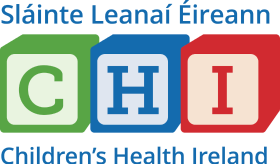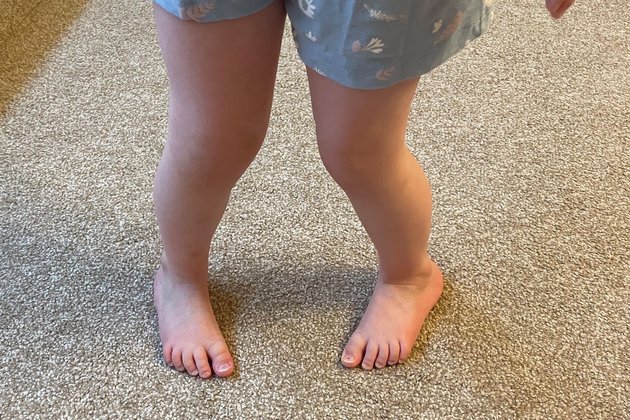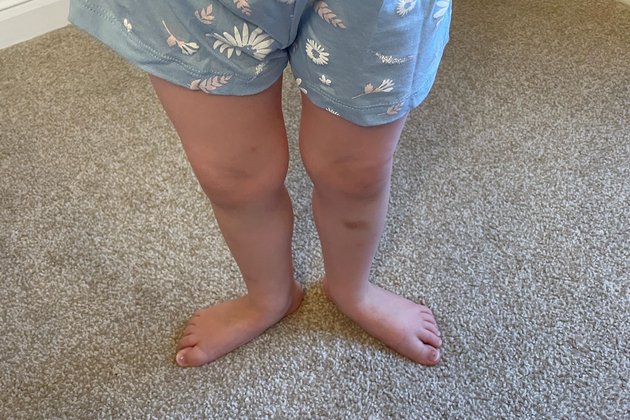In-toeing in children
In-toeing means that your child’s feet point inward when they walk or run. It is a very common reason for parents to visit their GP or orthopaedic specialist. In most cases, it is completely normal and improves over time without treatment. Most toddlers have some degree of these conditions at birth, which can make them look clumsy when they start walking. These changes usually improve naturally as they grow.
Why does in-toeing happen?
Children may in-toe because of a twist at their hip, a twist in their shin, or a curve in their foot. Continue reading to find further information and treatment options for each cause.
1. Femoral Anteversion: twist at the hip
- All babies are born with their thigh bones turned inwards.
- This improves with age. The twist at the hip changes from about 40° at birth to 15° as an adult.
- To walk with their feet facing forwards toddlers have to use their muscles to turn the leg outwards. As they get tired, the leg will tend to turn back in. As children get older, they get better muscle control and this becomes less of an issue.
- Even if it does not fully correct, it rarely causes problems.
Treatment:
- Treatment is not needed, unless a child's case is very severe.
- The only treatment is femoral de-rotational osteotomy (to break and re-set both femurs), which would never be considered until the age of 9 years.
2. Internal Tibial Torsion: twist in the shin
- Shin bones are often turned inwards at birth.
- They naturally twist outwards as the child grows, usually by age 4 to 6.
- This usually improves on its own and can even benefit some athletes.
Treatment:
- Surgery is rare.
- The only treatment is de-rotational osteotomy, which would not be considered until the age of 9 years.
3. Metatarsus Adductus: curve in the foot
This is a curve in the middle of the foot that can be divided into the following groups:
- Actively correctable: with this type of foot curve, when you scratch the border of the foot, the child can move the foot straight on their own. This needs no referral and will improve naturally.
- Passively correctable: with this type of foot curve, a doctor can fully correct the position of the foot. This needs referral to physiotherapy.
- Fixed contracture: this type of foot curvature cannot be straightened by hand. This needs urgent referral to orthopaedics for serial casting. Serial casting is a physical therapy technique involving a series of casts applied to a limb over time to gradually increase range of motion and improve muscle flexibility.
For GPs: Referral Recommendations
If your paediatric patient has on-going in-toeing which is symptomatic, then we would recommend referral at the following ages:
- Femoral anteversion: 9 years
- Internal tibial torsion: 9 years
- Fixed metatarsus adductus: Immediate to orthopaedics
- Passively correctable metatarsus adductus: Immediate to physiotherapy
Other causes of walking issues for children
Sometimes, walking issues in children may be due to other conditions. Signs to look out for include:
- Developmental Dysplasia of the Hip (DDH): possible signs of DDH include one leg shorter than the other, limited hip movement, waddling walk.
- Cerebral Palsy: possible signs of cerebral palsy include stiffness, abnormal reflexes, tight muscles.
- Spina Bifida: possible signs of spina bifida include weak legs, spinal abnormalities, changes in nerve function.
- Muscular Dystrophy: possible signs of Muscular Dystrophy include muscle weakness, difficulty standing, inability to stand up from a squatting or lying position without using their hands to climb up their own body (Gower sign).
Summary
- In-toeing is normal in many children and adults and usually gets better with growth.
- It does not cause arthritis and does not limit sport or activity.
- Surgery (de-rotational osteotomy) is rarely needed and is only considered if the condition is severe and persistent after age 9.
- In nearly all cases, no action is needed other than reassurance and monitoring.
- The opportunity for surgery continues into adult life but is extremely rarely required.
Further information on HSE website: https://www2.hse.ie/conditions/in-toeing-and-out-toeing/


